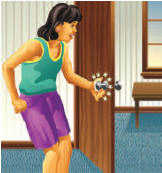A Little Lightning Advanced Activity
Background
 Electric charges can build up on an object, but an object doesn’t stay charged forever. Eventually the charged object will become neutral again as it gains or loses additional electrons. A loss of static charge is called static discharge.
Electric charges can build up on an object, but an object doesn’t stay charged forever. Eventually the charged object will become neutral again as it gains or loses additional electrons. A loss of static charge is called static discharge.
Static discharge can happen slowly, as when a balloon sticks to a wall, then, over time, falls to the floor. It can also happen quickly, as when you shuffle your feet on carpeting, then touch a metal doorknob. Zap! The sound you hear is the air heating and expanding from the energy in the spark.
 Lightning is nothing more than a sudden electric discharge—but on a very large scale. Raindrops in thunderclouds get tossed around by air currents. The friction causes them to become charged. The negatively charged drops collect in the bottom of the cloud, while the positively charged drops flow toward the top. When the opposite charges move toward one another to restore a neutral condition, a giant spark is created. ZAP!
Lightning is nothing more than a sudden electric discharge—but on a very large scale. Raindrops in thunderclouds get tossed around by air currents. The friction causes them to become charged. The negatively charged drops collect in the bottom of the cloud, while the positively charged drops flow toward the top. When the opposite charges move toward one another to restore a neutral condition, a giant spark is created. ZAP!
Thunder is caused by the heating and expansion of the air around the spark. Lightning and thunder occur simultaneously, but because light travels faster than sound, you will see lightning before you hear the thunder, unless the storm is directly overhead.
In this activity, you are going to build up electric charge on an object and then discharge it, producing miniature lightning bolts and thunder that sounds like, well, static. For best results, work in a quiet, dark room on a dry day.
Materials
- 1 balloon
Steps
- Blow up a balloon and tie it off. Turn off the lights and close the window shades. The room must be pitch-dark.
- Rub the balloon vigorously against your clean, dry hair. Then slowly move your clean, dry index finger toward the balloon. Repeat several times. What do you see and hear?
- Describe how electric charge builds up and is discharged in this activity.
- It takes about 5 seconds for sound to travel one mile. How far away is the storm if you hear thunder:
10 seconds after you see the flash?___________________________________________________15 seconds after you see the flash?___________________________________________________2.5 seconds after you see the flash?___________________________________________________

